Hoya Compact - the best varieties, home care
One of the most unusual varieties of wax ivy is the Compacta hoya, or Karnosa. It is considered a rarity in the collections of florists due to the relative difficulty of care. However, the decorativeness of this hoya is an order of magnitude higher than other subspecies, and with proper handling it will become the best decoration for any home.

Hoya compacta jodie silver
general description
The first thing that even an inexperienced grower will distinguish Compacta is the shape of the leaves. They curl in a bizarre way, so that the whole plant looks curly. The leaves have different colors, depending on the variety, but they are always dense and fleshy, placed on a thick, even stem.
The peculiarity of flowering is that "baskets" with buds are formed even on bare stems, in their area without leaves.
There are many flowers in each inflorescence - 25-30 pieces. Their aroma is not as sharp as that of other types of hoya, but it is very pleasant. The plant blooms only after 3 years of life.
Varieties
Over the years, several compact varieties have been bred, and the work is still in progress. Perhaps, in the future, the list of varieties will be expanded. Some of them are most common in the homes of ordinary flower growers, while others are extremely rare.
Variegata)
Differs in pronounced spots on twisted leaves. This effect is obtained as a result of a rare mutation in which some parts of the leaf blade are not subject to photosynthesis. They remain white, so they stand out against the background of the main split sheet.
Variegated hoya grows relatively quickly and blooms from May to September, but only under favorable conditions. She is warm and light-requiring, does not tolerate changes in position and drafts. It is not taken out onto the balcony, but placed on windows or well-lit walls near them.
A rare variety is Mauna Loa, or Lura Lei. The leaves are bent in half and twisted, there is a white stripe in the middle of the leaf, and it itself is dark green. The vines are long. They can grow up to 7 meters, but the flower grows slowly. Poorly rooted, therefore it is rarely found on the market.
It blooms magnificently, but not for long. Inflorescences are formed from 3-4 years of plant life. Each flower only blooms for 5-6 days. Due to the fact that the "baskets" bloom alternately, the total flowering period stretches for a month. The aroma of the buds is amazing, strong and persistent. All growers describe it differently, it is so exotic.
Regalis
Leaves are light green, strongly curled, with a wide white stripe along the edge. In general, the plant looks unusual, like a variegated cascade falling down from a hanging planter. The variety is particularly drought tolerant. It can withstand heat up to +30 ° С and above.
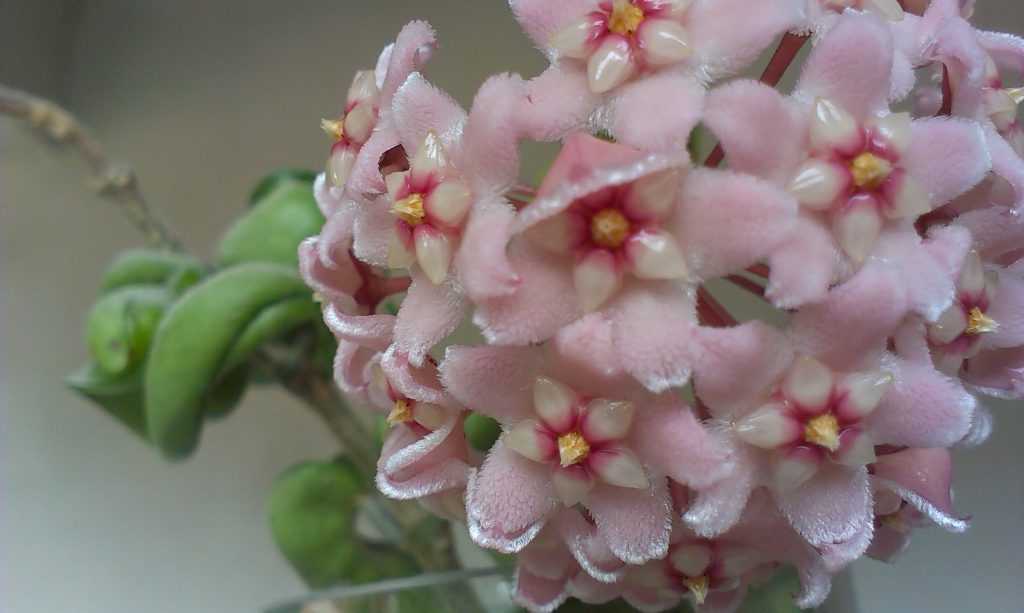
Hoya Compact
The flowers are pink, large, collected in neat spherical inflorescences. Each "basket" contains from 10 to 25 buds. The aroma is strong, intensifies in the evening, lasts throughout the entire flowering period.
Jodie Silver
The leaves are as if covered with silver, which adds to its unusualness. There is a light bloom both on the front and on the seamy side of the sheet. Vines are compact, do not grow longer than 3 meters. Hoya owners of this variety say that it is capricious and demanding to care for.
It can bloom at any time of the year, but more often it occurs in summer. Still, for the lush flowering of the hoye, a lot of sunlight is required. The variety branches strongly with regular pruning, blooming in the second year.
Purchase and adaptation
Any plant after purchase must first be adapted, and then placed in a permanent place. Hoya is no exception. Imported flowers are often contaminated with pests and infections, and it will take longer for them to get used to the microclimate in the house.
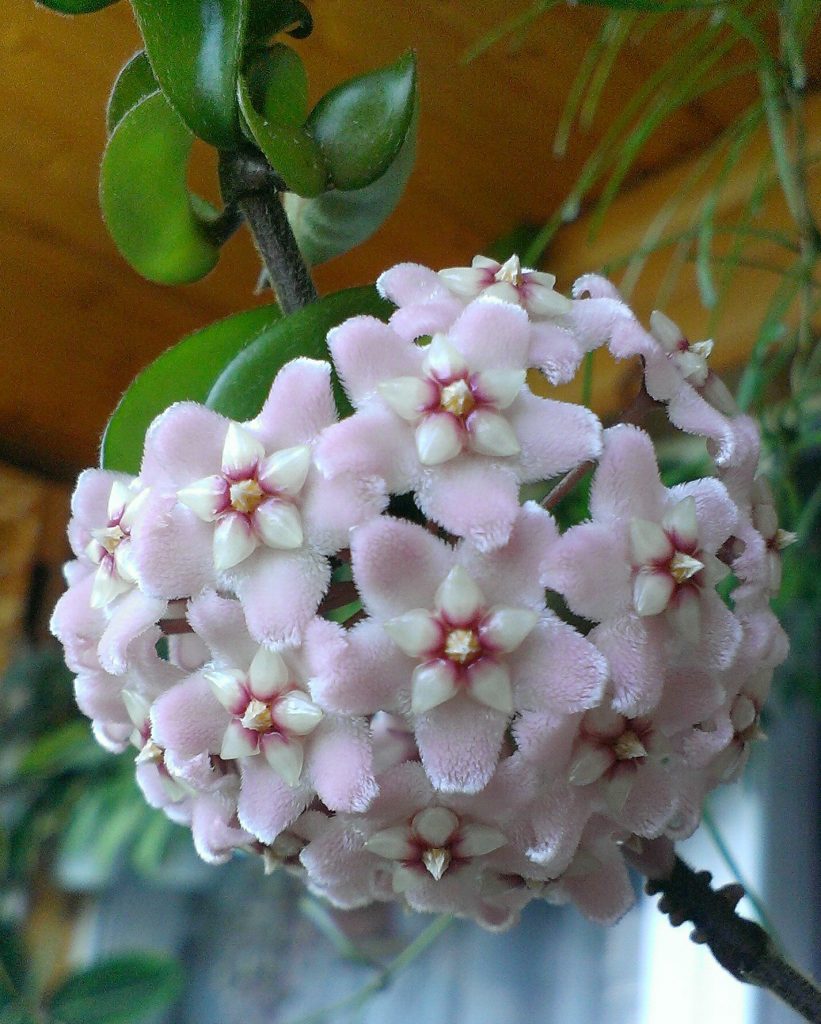
Hoya Compact description
In stores, hoyi are sold in flowerpots or special shipping containers. They must be transplanted into a more suitable soil. These are epiphytic succulents, the substrate for them must be appropriate.
After 2-3 weeks of quarantine, if everything is fine with the plant, there are no symptoms of the disease, you can determine it to a permanent place. The pot is placed next to the rest of the indoor flowers. Full adaptation of wax ivy takes 1-1.5 months.
Landing rules
Hoya loves bright lighting and warmth, so shady corners of the room and cold balconies will not work for her. The best place is a hanging planter on a window facing south or southeast.
Sometimes it grows on western windows, but it blooms very rarely. The northern side is contraindicated - the plant will stretch, grow very slowly and never bloom.
A succulent needs loose soil, with gravel and coarse sand, as well as leafy and turfy soil for food. He is afraid of waterlogging, so the substrate must be as moisture-permeable as possible in order to remove all the water. In bright light in a soil suitable for all parameters, the hoya will actively grow and bloom at any time of the year.
The necessary conditions
Despite the hoya's unpretentiousness and resistance to disease, it is important to strictly observe all conditions when growing it. The parameters must be extremely comfortable for the plant in order to enable it to grow and bloom.
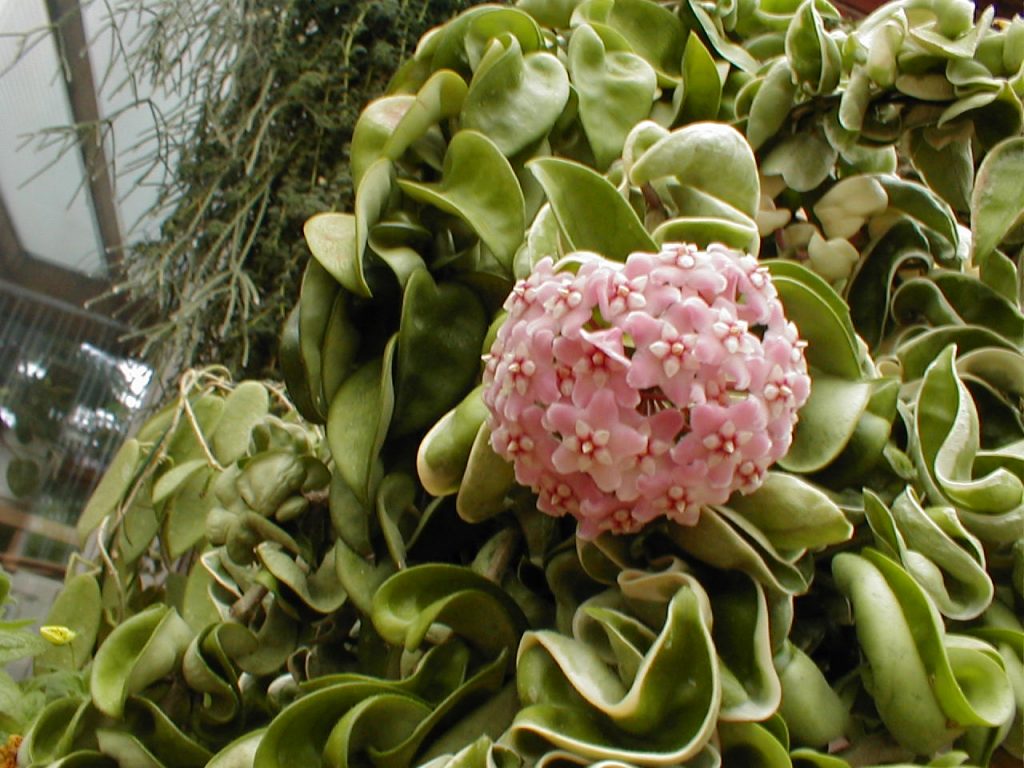
Hoya Compact photo
Humidity
Hoya cannot be waterlogged. Its fleshy leaves and stems retain water to nourish the flower; excess leads to decay of roots and leaves. Humidity at home should be in the region of 35-40%, but an increase to 50% will not be critical either. The plant tolerates drought better.
In the summer, you can occasionally irrigate the hoya from a spray bottle. They do this not so much for moistening as for cleaning the leaves from dust and dirt. Sometimes flower growers apply fertilizers for hoya "on the leaf", by foliar method. This does not affect the humidity level. Additional pallets with water or wet expanded clay should not be placed next to the flowerpot.
Temperature
The average temperature of the content is +22 ° C. In summer, the light is + 26-28 ° С, but for epiphytic ones this is always an advantage.
A heat-loving vine will grow and bloom better if the temperature is constant, without sudden changes.
In winter, a decrease to +16 ° C is allowed. In a colder room, the wax wax will stop growing and may start to hurt. As such, the evergreen liana does not have a rest period. It can bloom in any season under the right conditions.
Lighting
A lot of light is the main condition for active growth and flowering of any kind of hoya. Even direct sun does not harm this plant. It can be safely placed right on the window close to the glass or on a light glazed loggia.
In winter, the flower is illuminated with a phytolamp. This will stimulate growth, give a "push" for the formation of new peduncles. Many hoyis stop growing and wither during the winter due to lack of sunlight.
Care
Wax ivy needs just as much maintenance as any flowering plant.Depending on the variety, the maintenance rules differ slightly, but the main points remain the same.
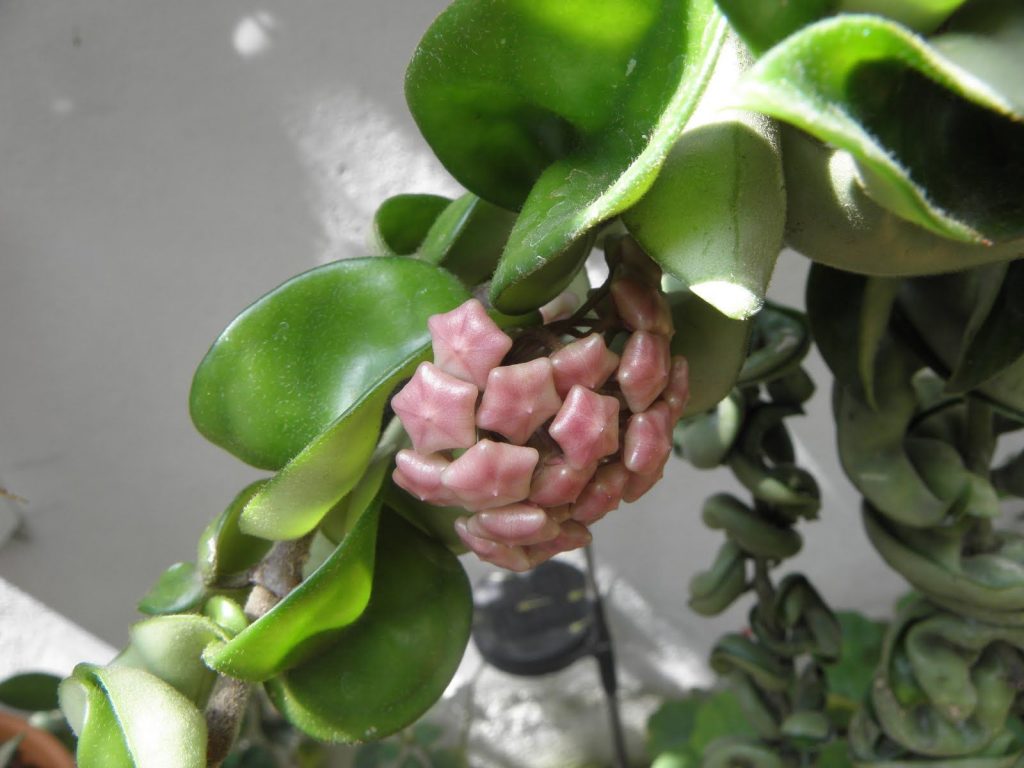
Hoya Compact reproduction
Watering
If the plant is planted in good breathable drainage, it will be difficult to flood. Hoya does not need a lot of moisture, it is able to accumulate it in the leaves and stems. In the summer, it is watered once a week, but abundantly so that the water flows out of the drainage holes.
In winter, when the temperature drops, it is better to reduce watering to 2 times a month. The procedure is carried out only during the day, and not at night.
You cannot spray. Waterlogging in the cold season is the main cause of illness and even death of the thermophilic vine.
Top dressing
In spring and summer, the waxen should be fed with mineral complexes for cacti and succulents. Their nutrient content has already been calculated and balanced.
It is impossible to fertilize vines with organic matter - this will cause the growth of harmful microflora in the soil. The plant is not able to grow under such conditions.
The best fertilizer complexes:
- Florovit;
- Stimulus;
- Etisso;
- Good power;
- Pocon;
- Gilea;
- Stimovit;
- Reasil;
- Uniflor Cactus.
Transfer
Hoya is often not worth replanting. She has not too developed roots, which will be enough for a small pot. True, this is provided that the soil is correctly selected. The first 3 years the plant is moved annually, then every 4-5 years.
The substrate for the hoya must be breathable, because the roots of the plant literally "breathe", like all epiphytes. A mixture of soil, coconut meal or moss, shredded wood, perlite and polystyrene foam will be the ideal medium for the growth and flowering of a vine.
Important! Regular soil (even if it is specially designed for succulents) in its pure form is not suitable for hoya. It must be supplemented with baking powder, and a layer of large drainage is required in the pot.
Reproduction methods
Some varieties reproduce easily at home; for some, special manipulations and the use of phytoharmonics are needed. There are two main breeding methods. But experienced florists manage to breed the flower in other ways.
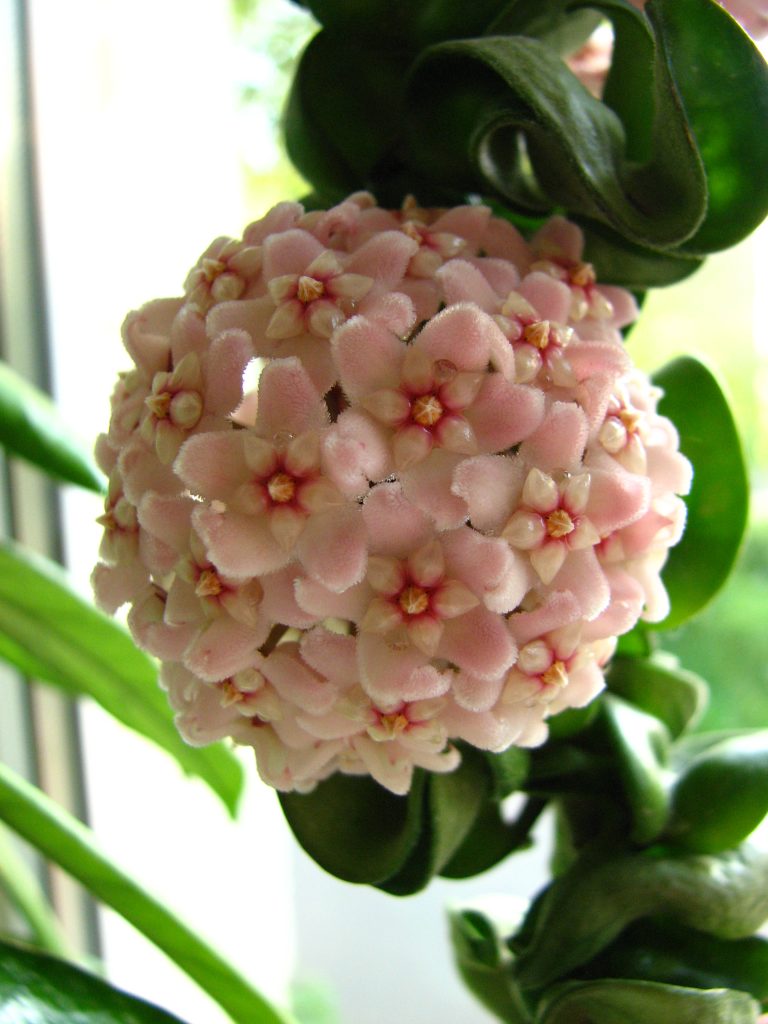
Hoya Compact care
Seeds
In stores, you can buy seeds of even very rare varieties, but it is impossible to assess their quality and germination. Manipulations e with any of them are carried out the same - soaking, preparation of the substrate, sowing. It is better to soak the seeds in such preparations as Epin Extra, Energen, Tsitovit.
After sowing, the container is covered and placed under a lamp or in a bright, warm place. At a temperature of +27 ° C, sprouts will appear in 10-12 days. The greenhouse is ventilated daily, the condensate is wiped off with a napkin. The sprouts are planted in separate pots after 2-3 months. The plant reaches its adult state in 3 years.
Cuttings
Any segment of the vine that is cut off can take root and form a new plant. Often, aerial roots form on the stems by themselves. In this case, it remains only to separate part of the vine from the root and place it in the substrate. If there are no roots on the stem, they are easy to obtain.
The cut cutting is placed in Kornevin for 10-12 hours. Then they transfer it to a substrate consisting of perlite and vermiculite (you can just use fine expanded clay). Watering immediately is not worth it.
The first watering will be in a week, then every 5-6 days. After 2-3 weeks, the cutting will take root, and after another month, young leaves will appear.
Diseases and pests
| Problem | Cause | Treatment | Prophylaxis |
| Peduncles are not formed | Insufficient light and nutrients | Apply mineral fertilizers, put in a bright light | Do not remove the flowerpot from the light, feed regularly |
| Leaves fall | Too dry air with insufficient watering | Water the flower abundantly | Spray the leaves in the heat |
| Leaves are deformed, curled | The flower is cold | Move to a warm room | The temperature should not fall below +16 ° С |
| The plant has stopped growing | Lack of nitrogen | Apply a complex of fertilizers with a predominance of nitrogen | Do not violate the feeding regime |
| Powdery mildew | Hot, humidity below 40% | Quadris, Skor, Topaz, Tilt | Ventilate the room, spray the flower |
| Spider mite | Infrequent watering, dry air | Anti-mite, Actellic, Fufanon | Regular inspection, adherence to the watering regime and humidity |
| Shield | Low humidity and heat | Karbofos, Neoron, Fitoverm | Inspection, compliance with the irrigation and humidity regime |
Useful videos
Hoya Compacta is a rare beauty liana with beautiful leaves and a fascinating aroma with unusual flowers. This splendor is easy to achieve if you follow all the conditions and carefully monitor the plant. Any change in his state is a response to leaving or his absence. With the right approach, hoya can bloom for a long time and every year.

